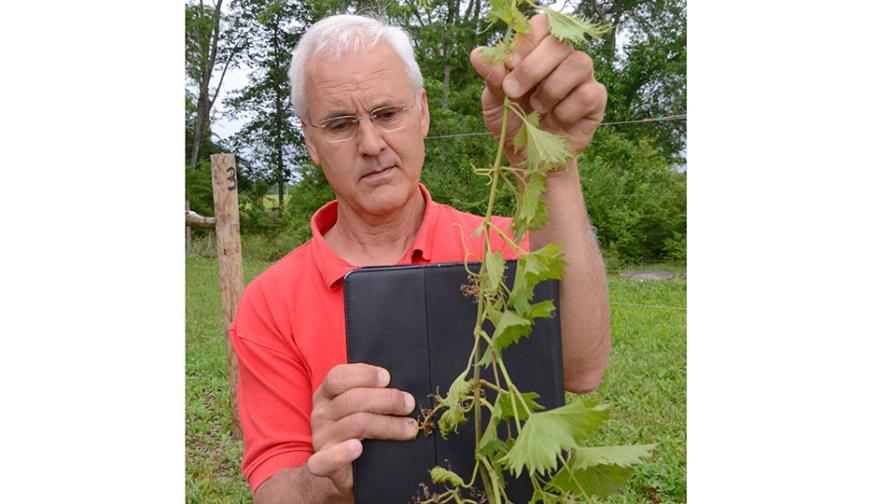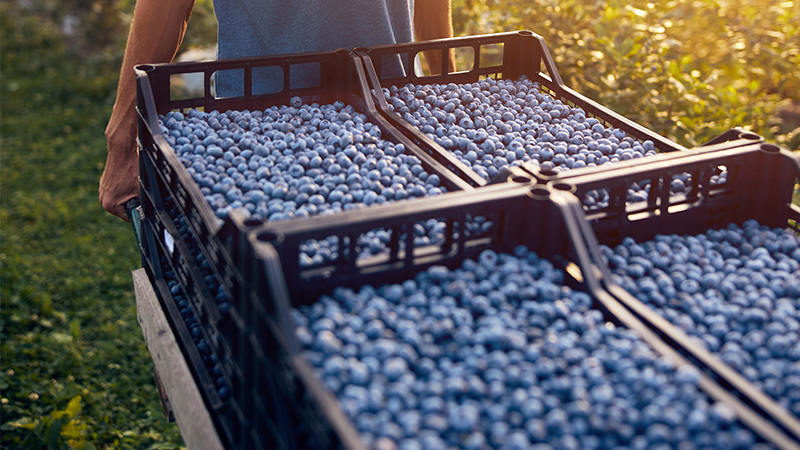What You Can Do To Protect Your Grapes From Herbicide Drift Damage
Herbicide drift has become a serious threat to specialty crops. Fruit crops are no exception. A quick search of the subject yields many articles, one in which a jury awarded $265M to a peach farmer in Missouri in 2020 for causing herbicide drift damage. Fruit growers across the nation are looking for ways to protect their crops and livelihood from this damage.
Herbicide drift damage is not a new problem. However, it’s been getting much more serious during the last five to 10 years. In February, I attended a presentation on the subject by Dr. Stephen Meyers, an Assistant Professor of Weed Science with Purdue University. Meyers says there has been a resurgent use of auxinic herbicides, such as dicamba and 2,4-D, due to herbicide resistance in weeds and a shift to glufosinate-resistant row crops.
Some of the symptoms of this damage include a cessation of shoot tip growth, an abundance of lateral shoots, leaf strapping, and fewer berries/clusters. Some of the symptomology of dicamba damage to grapevines are “elongated growth, upward leaf cupping, and few berries/clusters,” Meyers says.
STEPS YOU CAN TAKE
There may not be any “silver bullets” for such a complex problem, but a few steps you can take include informing your neighbors, registering your crops in an official online database in your state, taking samples and pictures of suspected damage, and filing a complaint with your state’s Department of Agriculture.
Additional steps, such as keeping detailed yield records, setting up a video recording device for evidence, and setting out detectors for herbicide collection, may be warranted.
Inform your neighbors — It is always a good idea to maintain good communication with your neighbors.
“We also encourage our specialty crop producers to get to know their neighbors. This can open lines of communication, build trust, and if an off-target event occurs, it can help the two parties reach an agreement about how to proceed,” Meyers says.
One grape grower I know in Ohio had his lawyer send a letter to the farmers near his vineyard. That measure may sound a little extreme, but I fully understand his frustration and reasoning.
Register your fruit plantings in an official online database in your state — It is important to register your fruit planting(s) in an official online registry. Ohio has been partnering with FieldWatch, Inc. to use the DriftWatch registry tool since 2018.
“Applicators of over-the-top formulations of auxinic herbicides are supposed to check with databases such at DriftWatch to determine the proximity of sensitive crops near their fields prior to making an application. We encourage all of our specialty crop producers to register their fields on DriftWatch,” Meyers says. Check with your own state Department of Agriculture for your official sensitive crop registry.

Dave Scurlock, a retired OSU Viticulture Outreach Specialist, shows a grape shoot with likely 2,4-D drift damage.
Photo by Dr. Gary Gao
Document damage — When you observe damage on your fruit crops, it is important to take lots of good pictures and take leaf and fruit samples as soon as possible. The first three days are most critical for sample collection. Look for evidence of a trail of symptoms on both cultivated and wild plants nearby. Leaf and fruit samples will need to be kept in a refrigerator. You will also want to work with your Extension professionals for tips and recommendations. It is hard to know how much documentation you will need since you may be dealing with your Department of Agriculture and/or an insurance company or even multiple insurance companies.
File a complaint with your Department of Agriculture — It is a good idea to keep all parties well informed. You may need to file a formal complaint against the person who may have caused the herbicide drift. Before herbicide drift damage occurs, consider finding out exactly what your Department of Agriculture will do once you file a complaint. These legal matters can get quite complicated. Will you get compensated for the damage? If yes, how much? How much is enough?
“Compensation is out of my wheelhouse,” Meyers says. “When I started working with growers affected by auxinic herbicide drift (sweetpotato farmers in Mississippi), it was difficult for them to get compensation because drift is often not covered by their specialty crop insurance — it was not ‘an act of God.’ To receive compensation will likely require identifying the source of the off-target movement and making a compelling case that crop loss occurred due to the drift event.
“Outside of complete crop failure, quantifying loss can be very difficult, especially in perennial crops. Another thing to keep in mind is that with dicamba, there is a zero tolerance for residue on the raw agricultural commodity at the time it is offered to the market (with the exception of sweet corn and asparagus). This could result in essentially a crop destruct scenario and complete crop failure, even if yield is not impacted,” he says.
The Benjamin Franklin adage that “an ounce of prevention is worth a pound of cure” is quite applicable to potential herbicide drift damage. It is much better to prevent damage from occurring in the first place. Check out your state’s information page on herbicide drift damage. In Ohio, Herbicide-Drift Risk Management for Specialty Crops offers excellent fact sheets. Another good resource is the Herbicide Symptoms website from the University of California Division of Agriculture and Natural Resources, which offers a searchable database of herbicide damage symptoms.
It is to your advantage to learn as much as you can to protect your fruit crops and your livelihood!











